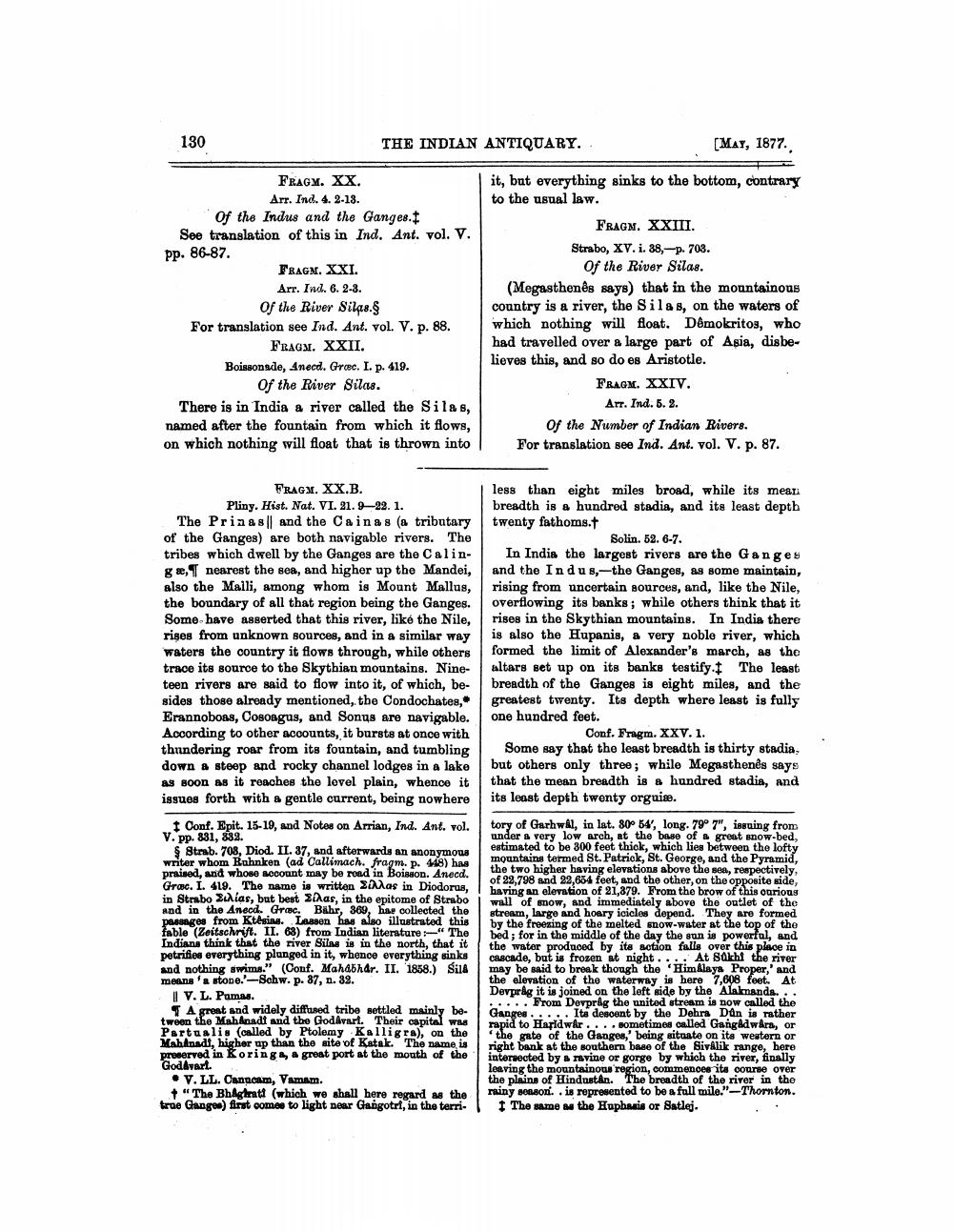________________
130
THE INDIAN ANTIQUARY.
[MAY, 1877.
Fragm. XX.
Arr. Ind. 4.2-13. Of the Indus and the Ganges. I See translation of this in Ind. Ant. vol. V. pp. 86-87.
FRAGM. XXI.
Arr. Ind. 6. 2-3.
of the River Silas. For translation see Ind. Ant. vol. V. p. 88.
FRAGM. XXII. Boissonsde, Anecd. Groec. I. p. 419.
Of the River Silas. There is in India a river called the Silas, named after the fountain from which it flows, on which nothing will float that is thrown into
it, but everything sinks to the bottom, contrary to the usual law.
FRAGM. XXIII. Strabo, XV. i. 38, p. 703.
Of the River Silas. (Megasthenês says) that in the mountainous country is a river, the Silas, on the waters of which nothing will float. Demokritos, who had travelled over a large part of Asia, disbelieves this, and so do es Aristotle.
FRAGM. XXIV.
Arr. Ind. 6. 2. Of the Number of Indian Rivers. For translation see Ind. Ant. vol. V. p. 87.
FRAGA. XX.B. Pliny. Hist. Nat. VI. 21. 9-22. 1. The Priaas and the Cainas (a tributary of the Ganges) are both navigable rivers. The tribes which dwell by the Ganges are the Calingæ, nearest the sea, and higher up the Mandei, also the Malli, among whom is Mount Mallus, the boundary of all that region being the Ganges. Some have asserted that this river, like the Nile, rises from unknown sources, and in a similar way waters the country it flows through, while others trace its source to the Skythian mountains. Nineteen rivers are said to flow into it, of which, besides those already mentioned, the Condochates, Erannoboas, Cosoagus, and Songs are navigable. According to other accounts, it bursts at once with thundering roar from its fountain, and tumbling down a steep and rocky channel lodges in a lake as soon as it reaches the level plain, whence it issues forth with a gentle current, being nowhere
I Conf. Epit. 15-19, and Notes on Arrian, Ind. Ant. vol. V. pp. 831, 832.
Strab. 708, Diod. II. 37, and afterwards an anonymous writer whom Buhnken (ad Callimach. fragm. p. 448) has praised, and whose account may be road in Boisson. Anecd. Groc. I. 419. The name is written as in Diodorus, in Strabo Σιλίας, but best Σίλας, in the epitome of Strabo and in the Anecd. Graec. Bähr, 369, hae collected the passages from Ktésins. Lassen has also illustrated this fable (Zeitschrift. II. 63) from Indian literature -" The Indiana think that the river Silas is in the north, that it petrifies everything plunged in it, whence everything sinks and nothing swims." (Conf. Mahabhar. II. 1858.) Sile means' stone.'-Schw. p. 87, n. 32. I V. L. Pamas.
A great and widely diffused tribe settled mainly between the Mahanadt and the Godavart. Their capital was Partualis (called by Ptolemy Kalligra), on the Mahanadi, higher up than the site of Katak. The name is preserved in Koring, a great port at the mouth of the Godkvart.
• V. LL. Canncam, Vamam.
+ "The BhAghratt (which we shall here regard as the trae Gangeu) first come to light near Gangotri, in the terri.
less than eight miles broad, while its mean breadth is a hundred stadia, and its least depth twenty fathoms.
Solin. 52. 6-7. In India the largest rivers are the Ganges and the Indus-the Ganges, as some maintain, rising from uncertain sources, and, like the Nile, overflowing its banks; while others think that it rises in the Skythian mountains. In India there is also the Hupanis, & very noble river, which formed the limit of Alexander's march, as the altars set up on its banks testify. I The least breadth of the Ganges is eight miles, and the greatest twenty. Its depth where least is fully one hundred feet.
Conf. Fragm. XXV. 1. Some say that the least breadth is thirty stadia, but others only three; while Megasthenes says that the mean breadth is a hundred stadia, and its least depth twenty orguiæ.
tory of Garhwal, in lat. 80° 54', long. 79° 7", issuing from under a very low arch, at the base of great snow-bed, estimated to be 300 feet thick, which lies between the lofty mountains termed St. Patrick, St. George, and the Pyramid, the two higher having elevations above the sea, respectively, of 22,798 and 22,664 feet, and the other, on the opposite side, having an elevation of 21,379. From the brow of this curious wall of snow, and immediately above the outlet of the stream, large and hoary icicles depend. They are formed by the freezing of the melted snow-water at the top of the bed; for in the middle of the day the sun is powerful, and the water produced by its action falls over this place in cascade, but is frozen at night.... At Sukhi the river may be said to break though the 'Himalaya Proper,' and the elevation of the waterway is here 7,608 foet. At Devprag it is joined on the left side by the Alaknanda... ...... From Devprag the united stream is now called the Ganges . . . . . Its descent by the Dehra Dan is rather rapid to Haridwar .... sometimes called Gang&dwars, or
the gate of the Ganges, being situate on its western or right bank at the southern base of the Siválik range, here intersected by a revine or gorge by which the river, finally leaving the mountainous region, commences ita course over the plains of Hindustan. The breadth of the river in the rainy season..is represented to be a full mile." -Thornton.
The same as the Huphasis or Satlej.




